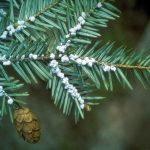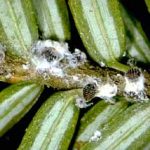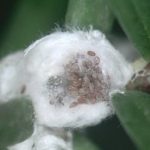Hemlock Woolly Adelgid
Identification:
Native to Asia, the hemlock woolly adelgid, or HWA, is an invasive, aphid-like insect that attacks North American hemlocks. HWA are very small (1.5 mm) and often hard to see, but they can be easily identified by the white woolly masses they form on the underside of branches at the base of the needles. Juvenile HWA, known as crawlers, can usually be found at the base of the needles. They insert their long mouthparts and begin feeding on the tree’s stored starches. HWA remain in the same spot for the rest of their lives, continually feeding and developing into adults. Their feeding severely damages the canopy of the host tree by disrupting the flow of nutrients to its twigs and needles. Tree health declines, and mortality usually occurs within 4 to 10 years.
Control:
Several insects from Asia have been studied, approved, and successfully introduced in HWA-infested areas. These insect predators serve as biological controls as they feed on HWA and reduce their populations. Three insect species from the Pacific Northwest continue to be introduced and their effectiveness as long-term solutions continue to be evaluated.
Specific chemical insecticides can be used to treat an already infested tree or as a preventive measure in a high-risk infestation area. They are useful for treating individual, ornamental, or high-value trees, but are not practical or economical in a forest setting. On some hemlock trees, the adelgid can be seen to have higher populations on specific branches. These branches can be cut, bagged, and removed, which may slow the spread of the HWA across the tree and can extend the lifespan of the individual tree.



